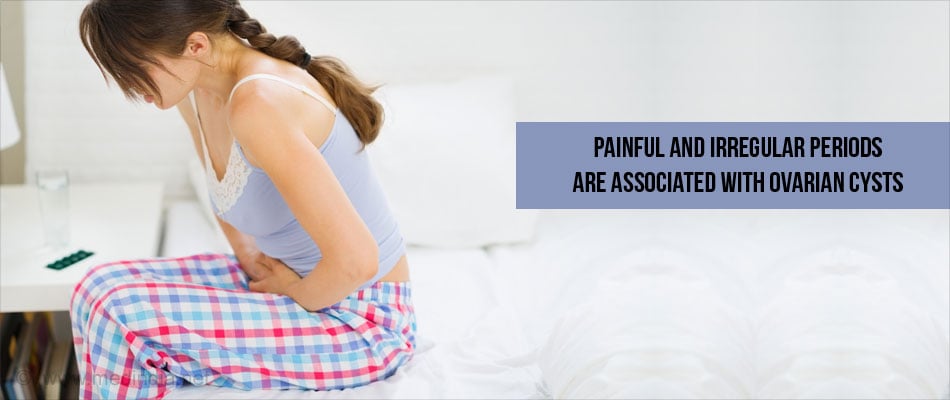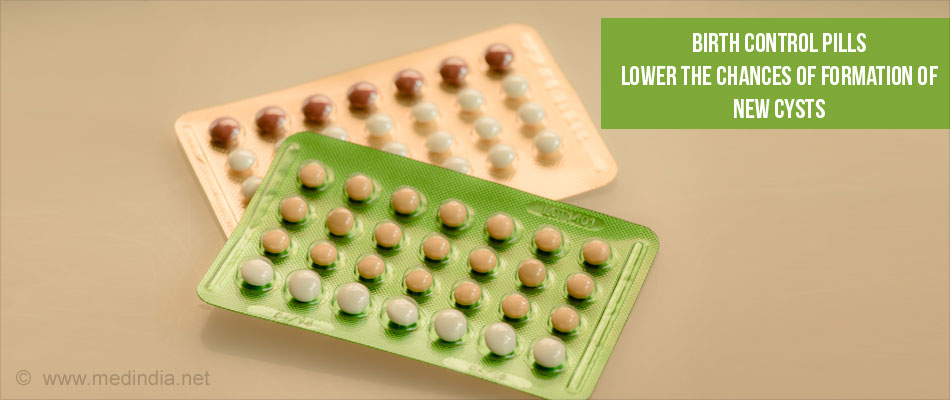- Theca Lutein Cyst - (http://radiopaedia.org/articles/theca-lutein-cyst)
- Information on Ovarian Cysts - (https://www.acog.org/-/media/for-patients/faq075.pdf?dmc=1&ts=20160726t0004569246)
- What are the Causes of Ovarian Cysts? - (http://www.mayoclinic.org/diseases-conditions/ovarian-cysts/basics/causes/con-20019937)
- Ovarian Cyst - An Introduction - (https://en.wikipedia.org/wiki/ovarian_cyst)
- Robbins and Cotran - Pathologic Basis of Disease, 8th Edition
- Pathology Secrets, Ivan Damjanov, 3rd Edition
What are Ovarian Cysts?
Ovarian cysts are fluid-filled sacs that occur within the ovary. They are fairly common among women in the reproductive age group. Most ovarian cysts are formed during the course of the menstrual cycle. Cysts may be of variable size.
They are usually harmless, cause no symptoms and very often detected during a routine pelvic examination.

Most cysts resolve on their own. Very rarely cysts may undergo complications or turn out to be cancerous. Such cysts need prompt treatment and removal.
Polycystic Ovarian Syndrome (PCOS) affects millions of women but is not a cystic disease of the ovary as the name indicates but results in multiple medical problems and serious health risks. PCOS has a genetic component and the person has menstrual irregularities, diabetes due to resistance to insulin. PCOS is not an ovarian condition.
What are the Types of Ovarian Cysts?
Ovarian cysts may be functional or neoplastic.
- Functional cysts are formed during the course of the normal menstrual cycle. They are generally harmless and usually resolve on their own within two to three months.
- Neoplastic cysts occur when there is inappropriate proliferation of cells within the ovary. They may be benign or malignant (cancerous). They are not related to the normal menstrual cycle.
Types of Functional Cysts
- Follicular Cysts form when the follicle does not rupture normally and release the egg (ovum). Instead it grows and develops into a cyst.
- Corpus Luteal Cyst – After the follicle ruptures and releases the egg, it develops into a structure called the corpus luteum. Occasionally a cyst may form in the corpus luteum when the opening formed during the release of the egg seals off and fluid accumulates within.
- Theca Lutein Cysts also known as hyperreactio luteinalis because the ovaries may enlarge greatly in size. They are typically multiple and seen bilaterally. Usually seen in gestational trophoblastic disease.
Types of Neoplastic Cysts
- Dermoid Cyst – The name derives from the fact that these cysts are lined on the inside by cells resembling those of the skin. Inside the cyst, one may find sebaceous or oily material, desquamated squames ("dandruff’’), hair and even a tooth occasionally.
- Cystadenoma/cystadenocarcinoma – These growths (tumors) arise from the lining cells of the ovary. Many of them are partly cystic. When the growth is benign it is termed a cystadenoma. If it is cancerous, it is referred to as cystadenocarcinoma.
- Endometrioma – Occasionally, uterine tissue may be found on other sites such as ovary, tubes and even rectum. Such ectopically occurring uterine tissue may enlarge and become a tumor (endometrioma). Cystic change may occur within this tumor and typically the cysts contain blood. These cysts are termed hemorrhagic cysts. When the blood turns dark brown over time, these cysts are referred to as ‘chocolate cysts’.
What are the Causes of Ovarian Cysts?
- Hormonal Disturbance
Polycystic ovary syndrome, or Stein–Leventhal syndrome, is a hormonal disturbance. The ovaries of these women contain numerous follicular cysts.
Clinically it presents with menstrual irregularities, obesity; and signs of virilization, such as hirsutism. Infertility is a major problem.
- Endometriosis – Condition where the uterine tissue is found in ectopic sites e.g. ovaries, tubes and rectum.

What are the Symptoms and Signs of Ovarian Cysts?
Usually there are no symptoms and maybe discovered during a routine ultrasound scan of abdomen or pelvis. When symptoms are present they include -
- Feeling of heaviness in the abdomen
- Dull pain in the lower hips that may radiate to back and thighs
- Painful intercourse (dyspareunia)
- Feeling the urge to urinate if the cyst presses on the bladder
- Pain during bowel movements
- Nausea, vomiting heartburn and indigestion
- Painful periods

What are the Complications Associated with Ovarian Cysts?
Complications occur infrequently. They include -
- Torsion – Large cysts displace the ovaries from their usual location within the pelvis. Due to this, the ovary may undergo twisting or torsioncausing severe abdominal pain often associated with nausea and vomiting.
- Rupture and bleeding – Occasionally a cyst may rupture into the peritoneal cavity causing peritonitis.
If bleeding has occurred, patient may be in shock. They may present with fainting, weak and rapid pulse and low blood pressure. Requires immediate hospitalization.
How do you Diagnose Ovarian Cysts?
An ovarian cyst may be detected during a routine pelvic examination. Further investigations may be required to find the size of the cyst, and type. This will help in deciding further treatment.
- Pregnancy Test – If the patient is pregnant, it is more likely that the cyst is a corpus luteum cyst. It will generally resolve by 14-16 weeks. Further investigations may be needed if the cyst persists beyond 16 weeks.
- Pelvic Ultrasound – Diagnostic test is done to detect the size and nature of ovarian cysts, whether functional, benign or cancerous.
- Laparoscopy - Surgical procedure that introduces an instrument called laparoscope through a surgical incision on the anterior abdominal wall. The structures of the abdominal and pelvic cavity are visualized including the ovaries. If any abnormalities are detected, the ovary may be removed.
Laparoscopy offers the advantage of reduced hospital stay and costs for the patient. The post-operative discomfort involved is also lesser and recovery occurs faster.

- CA-125 Levels – Blood levels of this protein are elevated in ovarian cancer. However this test is not diagnostic of ovarian malignancy. The levels are also elevated in other non-cancerous conditions such as endometriosis, uterine fibroids and pelvic inflammatory disease.
Also the test is not of value in pregnancy as the values are known to widely fluctuate.
How do you Treat Ovarian Cysts?
- Wait and Watch Policy – Ovarian cysts, especially the functional type are fairly common in women in the reproductive age group.
If the cyst is small, filled with fluid only, and shows no features suspicious of cancer, the doctor may decide to adopt a ‘wait and watch’ policy. He may recommend pelvic ultrasound examination at regular intervals to monitor the size of the cyst and look for other changes.
Most functional cysts resolve completely within three months.
- Birth Control Pills – These may be prescribed to reduce the chance of formation of functional cysts in the future. In addition, they reduce the risk of ovarian cancer.

- Surgery – This may be necessary for symptomatic cysts with pain, increase in size, or in cases of suspected cancer.
Generally ovarian cysts that occur in the post-menopausal age group are treated surgically as cancer is more common in this age group.
The type of surgery depends on the nature of the disease, age of the patient, and the patient’s desire to have children.
If the cyst is cancerous, complete removal of the uterus (hysterectomy), along with both the ovaries and tubes may be necessary (bilateral salpingo-oophorectomy).
If the patient wishes to have children, only the affected ovary (oophorectomy) may be removed, leaving the other ovary intact.
If both the ovaries are affected, then a procedure called cystectomy is performed. It involves removal of only the cystic portions, leaving the unaffected parts of the ovary behind.
Ovarian Cysts and Pregnancy
Most pregnancy-associated cysts are follicular or corpus luteal cysts. They generally resolve within 14-16 weeks of pregnancy.
If the cyst persists for longer, it has to be evaluated by ultrasound study. If the cyst appears benign and asymptomatic, no further intervention is required.
Symptomatic ovarian cysts, and cysts that look cancerous on ultrasound examination may require removal. A CT scan will be required before planning surgery.
The timing of surgery is decided based on the risk to fetus and consequences of delaying treatment for the patient.
Health tips
- Women in the reproductive age group should undergo a complete gynecological check-up at least once a year.

- If there is a family history of gynecologic cancer, especially in first degree relatives, consult a gynecologist for advice on prevention.










